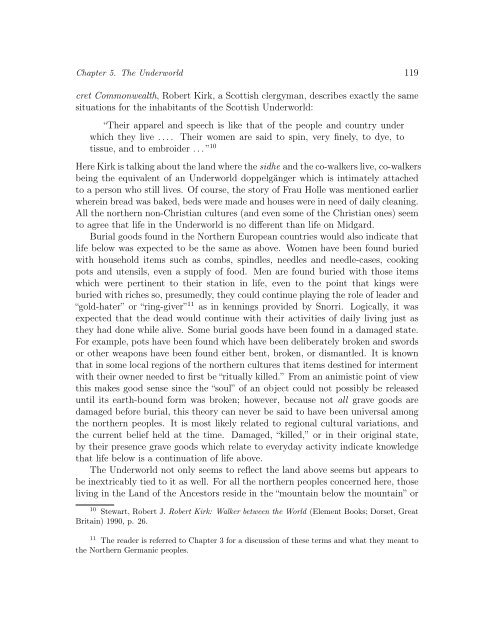Untitled - Awaken Video
Untitled - Awaken Video
Untitled - Awaken Video
Create successful ePaper yourself
Turn your PDF publications into a flip-book with our unique Google optimized e-Paper software.
Chapter 5. The Underworld 119<br />
cret Commonwealth, Robert Kirk, a Scottish clergyman, describes exactly the same<br />
situations for the inhabitants of the Scottish Underworld:<br />
“Their apparel and speech is like that of the people and country under<br />
which they live . . . . Their women are said to spin, very finely, to dye, to<br />
tissue, and to embroider . . . ” 10<br />
Here Kirk is talking about the land where the sidhe and the co-walkers live, co-walkers<br />
being the equivalent of an Underworld doppelgänger which is intimately attached<br />
to a person who still lives. Of course, the story of Frau Holle was mentioned earlier<br />
wherein bread was baked, beds were made and houses were in need of daily cleaning.<br />
All the northern non-Christian cultures (and even some of the Christian ones) seem<br />
to agree that life in the Underworld is no different than life on Midgard.<br />
Burial goods found in the Northern European countries would also indicate that<br />
life below was expected to be the same as above. Women have been found buried<br />
with household items such as combs, spindles, needles and needle-cases, cooking<br />
pots and utensils, even a supply of food. Men are found buried with those items<br />
which were pertinent to their station in life, even to the point that kings were<br />
buried with riches so, presumedly, they could continue playing the role of leader and<br />
“gold-hater” or “ring-giver” 11 as in kennings provided by Snorri. Logically, it was<br />
expected that the dead would continue with their activities of daily living just as<br />
they had done while alive. Some burial goods have been found in a damaged state.<br />
For example, pots have been found which have been deliberately broken and swords<br />
or other weapons have been found either bent, broken, or dismantled. It is known<br />
that in some local regions of the northern cultures that items destined for interment<br />
with their owner needed to first be “ritually killed.” From an animistic point of view<br />
this makes good sense since the “soul” of an object could not possibly be released<br />
until its earth-bound form was broken; however, because not all grave goods are<br />
damaged before burial, this theory can never be said to have been universal among<br />
the northern peoples. It is most likely related to regional cultural variations, and<br />
the current belief held at the time. Damaged, “killed,” or in their original state,<br />
by their presence grave goods which relate to everyday activity indicate knowledge<br />
that life below is a continuation of life above.<br />
The Underworld not only seems to reflect the land above seems but appears to<br />
be inextricably tied to it as well. For all the northern peoples concerned here, those<br />
living in the Land of the Ancestors reside in the “mountain below the mountain” or<br />
10 Stewart, Robert J. Robert Kirk: Walker between the World (Element Books; Dorset, Great<br />
Britain) 1990, p. 26.<br />
11 The reader is referred to Chapter 3 for a discussion of these terms and what they meant to<br />
the Northern Germanic peoples.
















